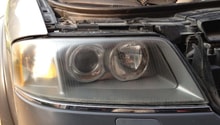Audi: Why are My Headlights Dim?
Dim headlights on your Audi fail to provide adequate visibility at night. Here are some reasons why this issue may be occurring, and how you can fix it.
This article applies to the Audi A6 C5/C6, A3, A4 B7/B8, Q5/Q7.
When it comes to figuring out why the head lamps on your Audi have started to dim, the first question that you might want to ask yourself is, "How old are my light bulbs?" It's easy to overlook this question, as rarely do we ever stop to think about how quickly time has passed since we first purchased our vehicle. If you purchased your Audi used, then you might have noticed the issue becoming worse and worse after just a few years of owning your vehicle. Generally, the rule of thumb is that you will have approximately 2,000 to 4,000 hours of light with a single bulb. Keep in mind that other factors can also contribute to the dimming effect you are currently experiencing. Let's go over what they are.

Materials Needed
- Head lamp restoration kit with multi-grit sandpaper, a head lamp cleaner and a sanding lubricant
- Replacement bulb(s)
- Microfiber cloth
- Masking tape
- Volt meter
Step 1 – Clean the lenses
They might be covered in a milky white film that is causing them to appear dim.
It is common for head lamps to develop a milky white film over time. To combat the problem, you'll need to use a head lamp restoration kit.
- Mask off the area of the lense, and then start by sanding away any stubborn deposits. Such deposits are the greatest contributors to the film you currently see.
- A general rule of thumb is to start with a coarse grit before moving on to a fine grit.
- Be sure to add a lubricant before and during the sanding process.
- Once the deposits have been lifted, rinse them away.
- Now, clean the lens using the head lamp cleaner that came with your kit.
- Rinse your lens one final time, and then dry off the water using a microfiber cloth.
- You can apply an optional protective film that you can peel off as it becomes worn down.

Pro Tip
Protective films can range in price from $25 to $75 and are available online as well as through local auto parts stores.
Step 2 – Check the inside of the head lamps
The lenses might be accumulating water condensation, causing your bulbs to blow.
Some Audi owners have reported seeing water condensation along the interior of their head lamps.
- Check the official Audi website to determine if your vehicle is currently part of a recall campaign or if the warranty on your head lamps is still active.
- Audi has extended the warranty on select models, and your vehicle might be one of them.
- If you choose to check the inside of your head lamps, you will need to remove the head lamp(s).
- This will include removing the connecting bolts, harness connector and bracket.
- You will then be able to lift out the head lamp by hand.
- (See "Related Discussions" for detailed instructions.)

Pro Tips
- You might also want to check the alignment of your head lamps to ensure it is correct and not contributing to the issue. Poor alignment can restrict light output.
- As well, check that you've installed the correct bulbs and that they are outputting the correct intensity of light. If your bulb(s) appear dim (without the lens), they are most likely burning out and will need to be changed.
Step 3 – Check the alternator
It might be failing, causing fluctuating voltage in your head lamps.
Go ahead and grab a volt meter to check that your alternator is not failing.
- Depending on the voltage reading you pick up on your alternator, you might need to have it replaced.
- The biggest indicator of a problem is that your head lamps go from bright to dim while you drive.
- As an added tip, you might want to steer clear of high-voltage bulbs, which pull more energy. Your wiring may not be able to accommodate them.

Pro Tip
Go ahead and check that your bulbs are receiving a sufficient amount of energy using a volt meter.
Related Discussions and Videos
- Head Lamp Cleaning Tips - Audiworld.com
- Head Lamp Removal in A4 and A5 - YouTube.com
- Head Lamp Removal in A3 - YouTube.com
- Alternative Repair - Audiworld.com
- Head Lamp Alignment - Audiworld.com
- Audi Recommended Amperage - Audiworld.com






